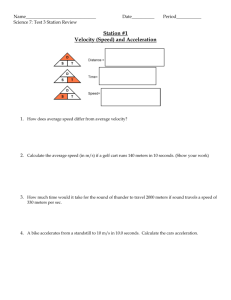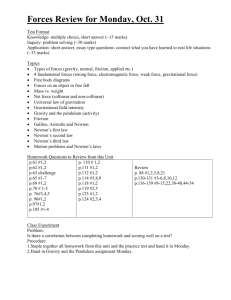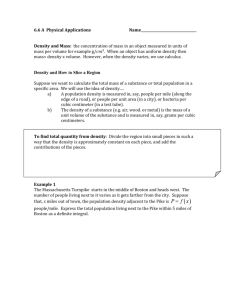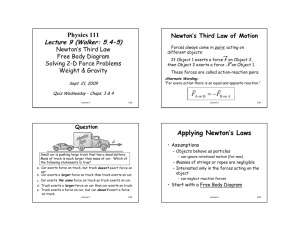Section 1
advertisement
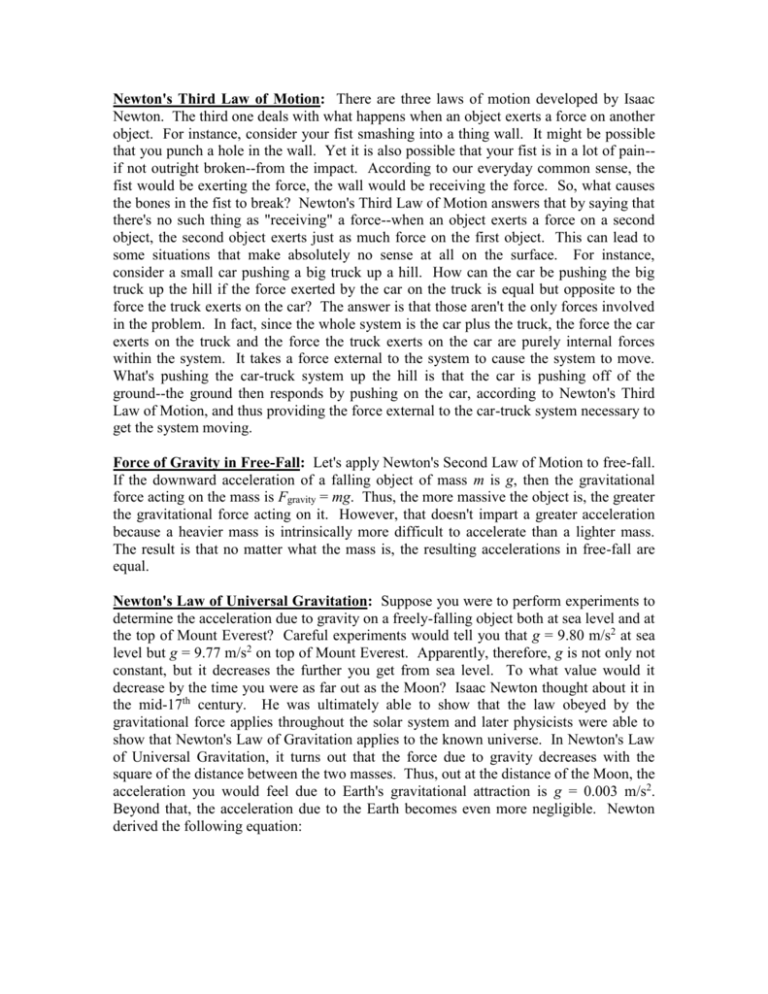
Newton's Third Law of Motion: There are three laws of motion developed by Isaac Newton. The third one deals with what happens when an object exerts a force on another object. For instance, consider your fist smashing into a thing wall. It might be possible that you punch a hole in the wall. Yet it is also possible that your fist is in a lot of pain-if not outright broken--from the impact. According to our everyday common sense, the fist would be exerting the force, the wall would be receiving the force. So, what causes the bones in the fist to break? Newton's Third Law of Motion answers that by saying that there's no such thing as "receiving" a force--when an object exerts a force on a second object, the second object exerts just as much force on the first object. This can lead to some situations that make absolutely no sense at all on the surface. For instance, consider a small car pushing a big truck up a hill. How can the car be pushing the big truck up the hill if the force exerted by the car on the truck is equal but opposite to the force the truck exerts on the car? The answer is that those aren't the only forces involved in the problem. In fact, since the whole system is the car plus the truck, the force the car exerts on the truck and the force the truck exerts on the car are purely internal forces within the system. It takes a force external to the system to cause the system to move. What's pushing the car-truck system up the hill is that the car is pushing off of the ground--the ground then responds by pushing on the car, according to Newton's Third Law of Motion, and thus providing the force external to the car-truck system necessary to get the system moving. Force of Gravity in Free-Fall: Let's apply Newton's Second Law of Motion to free-fall. If the downward acceleration of a falling object of mass m is g, then the gravitational force acting on the mass is Fgravity = mg. Thus, the more massive the object is, the greater the gravitational force acting on it. However, that doesn't impart a greater acceleration because a heavier mass is intrinsically more difficult to accelerate than a lighter mass. The result is that no matter what the mass is, the resulting accelerations in free-fall are equal. Newton's Law of Universal Gravitation: Suppose you were to perform experiments to determine the acceleration due to gravity on a freely-falling object both at sea level and at the top of Mount Everest? Careful experiments would tell you that g = 9.80 m/s2 at sea level but g = 9.77 m/s2 on top of Mount Everest. Apparently, therefore, g is not only not constant, but it decreases the further you get from sea level. To what value would it decrease by the time you were as far out as the Moon? Isaac Newton thought about it in the mid-17th century. He was ultimately able to show that the law obeyed by the gravitational force applies throughout the solar system and later physicists were able to show that Newton's Law of Gravitation applies to the known universe. In Newton's Law of Universal Gravitation, it turns out that the force due to gravity decreases with the square of the distance between the two masses. Thus, out at the distance of the Moon, the acceleration you would feel due to Earth's gravitational attraction is g = 0.003 m/s2. Beyond that, the acceleration due to the Earth becomes even more negligible. Newton derived the following equation: Fgravity m GM r2 where m is the mass of the object in question, M is the mass of the body to which the first object is attracted (e.g., the Earth), r is the distance from the center of the first body to the center of the second body, and G is known as the "gravitational constant of the universe. G is equal to 6.67 x 10-11 N·m2/kg2, which means that it's a very small number. This is indicative of the fact that as fundamental forces go, gravity is very weak. Note also that r doesn't represent the distance from the surface of either body but from the centers. Thus, at sea level on Earth, r is not equal to zero but is, instead, equal to the radius of the Earth. We can compare the equation above with the equation we previously had for the gravitational force, Fgravity = mg. When we compare these, we find g = MG/r2. If we plug in the radius of the Earth, 6.37 x 106 m and the mass of the Earth, 5.98 x 1024 kg, we get g = 9.83 m/s2. This agrees very well with the measured value of 9.80 m/s2 (when the effects of the Earth's rotation are included, we find that theory and experiment are in excellent agreement). The "inverse-square law" is very common in physics. Aside from gravity, other phenomena that are affected this way include electromagnetism and intensity (sound, light and radiation). The inverse-square law of gravity gives rise to extreme gravitational "gradients" found near black holes. Suppose we have a black hole with the mass of the Sun; its event horizon would then have a radius of 2954 m (almost 3 km). Suppose you are standing straight up just beyond the event horizon (your feet are 2955 m away from the center of the black hole). If you are 1.8 m tall (about 5'11") then your head is at about 2956.8 m away from the center of the black hole. Let's say your mass is 80 kg (about 177 pounds). Then the difference in the gravitational forces you feel GmM 6.67 10 11 80 1.99 1030 Ffeet 1.22 1015 N 2 2 r 2955 11 GmM 6.67 10 80 1.99 1030 Fhead 1.211015 N 2 2 r 2956.8 F Ffeet Fhead 1.5 1012 N. Admittedly, we made some approximations for the masses involved, but even if this calculation is off by a factor of 100, that would still leave a force difference of about 10 10 N between your head and feet. This is equivalent to having a mass of 10 10/9.8 109 kg tied and dangling from your feet--a modern aircraft carrier. As you inch closer to the event horizon, this differential gets even more extreme. This is what we mean by a sharp gradient (like a steep hill) and this is the effect of the inverse-square law.
